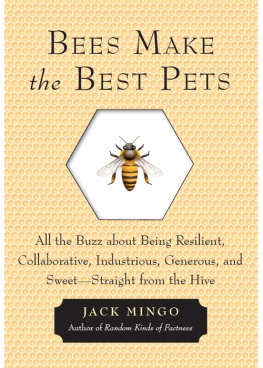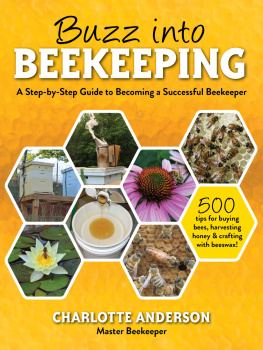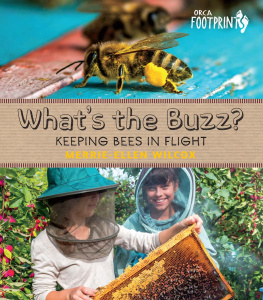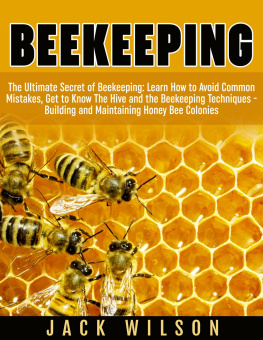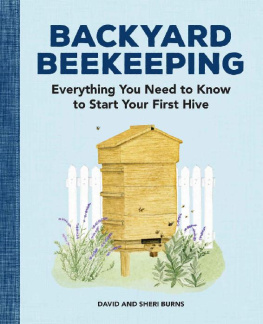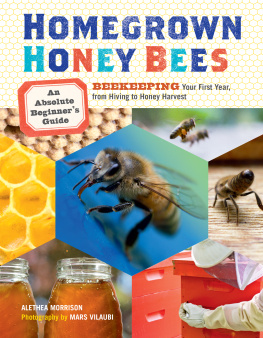
First published in 2013 by Conari Press, an imprint of
Red Wheel/Weiser, LLC
With offices at:
665 Third Street, Suite 400
San Francisco, CA 94107
www.redwheelweiser.com
Copyright 2013 by Jack Mingo
All rights reserved. No part of this publication may be reproduced or transmitted in any form or by any means, electronic or mechanical, including photocopying, recording, or by any information storage and retrieval system, without permission in writing from Red Wheel/Weiser, LLC. Reviewers may quote brief passages.
Library of Congress Cataloging-in-Publication data
Mingo, Jack, 1952
Bees make the best pets : all the buzz about being resilient, collaborative, industrious, generous, and sweetstraight from the hive / Jack Mingo.
p. cm.
ISBN 978-1-57324-625-5
1. Bees. 2. BeesPopular works. 3. BeesBehavior. I. Title.
QL56.M56 2013
595.799dc23
2013021999
Cover design by Jim Warner
Cover photograph Photosearch.com
Interior by Dutton & Sherman
Printed in the United States of America
VG
10 9 8 7 6 5 4 3 2 1
The paper used in this publication meets the minimum requirements of the American National Standard for Information SciencesPermanence of Paper for Printed Library Materials Z39.48-1992 (R1997).
www.redwheelweiser.com
www.redwheelweiser.com/newsletter
Dedicated to Reverend Lorenzo Lorraine Langstroth (18101895), whose revolutionary hive helped make modern beekeeping possible.
Contents
Prologue
SILENT NIGHT, BUZZ BUZZ BUZZ BUZZ
It's midnight on Christmas Eve and I'm outside in the cold getting ready to press my ear against a beehive. The reason may not make a lot of sense to you.
I'm not sure it makes a lot of sense to me, either. It's the result of a promise I'd made to myself in September, an easy commitment in daylight and warm weather. Tonight, though, I left a warm bed to stumble into the feral part of my backyard, the ground made treacherously uneven from a multi-year conspiracy of chickens and moles attacking from above and below. Worse, I am forced to depend on light from a street lamp and the neighbors' reflected Christmas displays because I haven't carried a light. There were two reasons for this. One, I hadn't wanted my neighbors to see what I was up to, and two, I didn't want to rouse the targets of my midnight reconnaissance: the bees.
Why am I doing this, you ask?
Okay, I'll come clean. I had read that long ago English beekeepers decked their hives with boughs of holly on Christmas Eve. Then, late at night, they'd slink quietly back into the bee yard and wait. They did that, they said, because the bees serenaded them each year by quietly humming Christmas carols at the stroke of midnight.
It's not that I believed it, of course, but the story touched me deeply in ways I didn't fully understand. I wanted it to be true, in the same way I wanted everything to be true about Christmas. There's so much about the holiday that demands a total suspension of logic, from Santa to the half-god baby born to a virgin. Why not toss carol-singing bees into the mix?
To be honest, there was never a moment that I believed the bees would hum carols, but I liked the idea of the ceremony, the tradition of honoring insect friends by being with them at a special time on a significant night. I admit also that I was curious about how a story like that got started. Is it possible that random beehive sounds upon a midnight clear could really somehow sound like a glorious song of old? You know, like how your brain tries to hear words and patterns from radio static or crowd noises? Perhaps random buzzing, filtered through a mix of holiday spirituality and strong spirits, could sound something like Adeste Fideles. I wanted to find that out, too.
I suspected that maybe the story was just a beekeepers' hoax, a way to reserve a quiet place away from others to think, drink, or meditate upon the season, but whatever the case, I intended to find out for myself tonight.
I stop a couple of yards away from the hives and notice how quiet everything is. On summer nights, you can hear the buzz of the hive at any hour, like a miniature factory running 24/7, as the bees ceaselessly clean, form wax combs, tend the babies, cool the hive, and dry the flower nectar into thick honey. On December 24, though, because the bees have no reason to cool the hive (on the contrary!) and no nectar to dry, the hives sound more like the ghost factories of Detroit, not just silent but freakishly so.
I step forward and squat down next to the hive. Still no sound. It occurs to me that old English beekeepers didn't use wooden boxes like mine but skeps woven from straw and reeds. Maybe sound carried better through them. Concerned about disturbing the bees, I hadn't intended to touch the hive at all, much less with my unprotected ear, but clearly I had no choice. It's almost midnight on Christmas Eve, and I don't want to have to wait another year to try again. So I gently brush my fingertips across the top of the hive, clearing off some of the dew and dirt, and gingerly lower my head, ear first, to the lid of the hive.
The surface is cold and damp and I'm a little afraid, but that's quickly forgotten because I hear something through the lid: the bees!

On December 24
the hives sound more
like the ghost
factories of Detroit,
not just silent but
freakishly so.

It's a different sound from the daytime hive, lower and more uniform, a steady, pulsing drone, like the sound of a... what? It's familiar and soothing, but I can't figure out what it sounds like. It sort of reminds me of the oddly comforting hum of a cheap 1970s-era electric clock that I used to have next to my bed, but that isn't quite it.
Still, I'm here to answer a question: do the bees make any sound that could be interpreted as a Christmas carol? I listen; the sound drones on in a pulsing monotone, never changing rhythm or pitch, the bees flexing their wing muscles to generate heat. This doesn't sound anything like carols. I reluctantly have to admit that Catholic monks singing a Gregorian chanteven Buddhist monks droning Omare more musical than a beehive on a Christmas midnight. Even if nursing a half gallon of mead, there's no way an honest beekeeper could claim to hear a Christmas carol from that.
I sigh, frankly surprised that I'm disappointed. It's cold. I'm tired. My quest for knowing is over. I should go back inside. Yet, I stay and listen to the sound. There's something in that buzz that's deeper and older than Christmas carols, or even Christmas. The roar of a river? Not exactly. The roar of a lion? Closer, but more soothing.

I reluctantly have to
admit that Catholic
monks singing a
Gregorian chant
even Buddhist monks
droning Omare
more musical than a
beehive on a
Christmas midnight.

Then it strikes me: a beehive on a cold winter night, settled in for warmth, sounds like a purring cat. I suddenly realize that this purr existed long before house cats, or even before humanity was there to hear it. There are fossils of honey bees that are 23 to 56 million years old. Saber tooth tigers and mastodons may have heard this sound. In fact, some scientists believe bees may go even further back, all the way to the dinosaur era. I realize that maybe even sweet-toothed sugiyamasauruses heard this sound.
Next page
